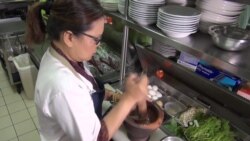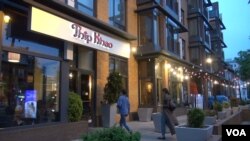Seng Luangrath has been cooking since she was seven years old.
“Cooking is my passion. When I cook, I put 100 percent of my heart and soul into what I am making.”
Seng Luangrath learned many of her skills from her grandmother in Laos.
Now, she operates a popular restaurant in Washington, D.C. She spoke to VOA recently about her life and cooking.
“My mom was too busy working. So I had to cook for my three other siblings. I remember it was a joy for me to learn, to observe whatever my grandmother will give me an assignment to do.”
Her family fled Laos in 1981 as the country struggled with the effects of the Vietnam War. They went to Thailand, where they spent two years at a refugee camp. There she learned to prepare different kinds of food.
“I was 12 years old. I learned how to cook from my neighbors. We have neighbors from all over Laos. So, I got myself exposed to different types of Lao cooking.”
Then, her family moved to the U.S. West Coast and settled in the San Francisco Bay area.
Seng Luangrath was the oldest child. She continued to cook for the family while her parents had jobs and worked long hours.
Many years later, she has taken that experience and used it to launch the first Lao restaurant in Washington.
Sticky rice
Chef Seng, as she is called, opened her restaurant in 2014. At the time, Lao food was unknown in the D.C. area.
She started in the restaurant business by working at a Thai eatery just outside Washington. Once that business was profitable, she began to offer its customers some Lao dishes.
She said few of the people who come to her restaurant know about Lao dishes or even where Laos is.
So, she has to teach Americans about the food and her homeland.
Lao food, or cuisine, is different from other cooking traditions in Southeast Asia. But it is also the same as the cuisine of northeastern Thailand, an area called Isan. It was once was part of Laos.
On her website, Chef Seng says people in the Isan area speak a form of the Lao language and they eat many of the same foods, including sticky rice. She says the Lao probably eat more sticky rice than any other people in the world. It also helps explain the name of her restaurant, Thip Khao.
“Thip Khao means a basket, a vessel that hold stick rice. It’s a part of Lao culture. If you go to Lao households, you’re always going to see Thip Khao. It’s a basket that is also meaningful for our Lao culture as well.”
An important part of her success is the fresh taste of her dishes. There are some herbs and vegetables that she cannot find in stores near Washington. So she grows them at home.
She said an example of this is Kaffir lime leaves, which she adds to salads.
The restaurant industry also has noticed Seng’s work. She said she was surprised to learn that her business was nominated as one of the 50 best new restaurants in America by the food magazine Bon Appétit. The nomination came less than one year after her eatery opened.
And this year, Seng was nominated as a Best Chef – Mid-Atlantic semifinalist for a restaurant industry award: the James Beard Award. She also was nominated last year.
However, the biggest award, Seng said, is doing what she loves. She said cooking makes her happy and is an important part of her life.
I’m Mario Ritter.
June Soh reported this story for VOA News. Mario Ritter adapted it for VOA Learning English. George Grow was the editor.
We want to hear from you. Write to us in the Comments section, and visit our Facebook page.
_____________________________________________________________
Words in This Story
types – n. kinds, forms
dishes – n. food that is prepared in a special way
cuisine – n. a kind of cooking
vessel – n. a container for holding liquids
passion – n. a strong feeling
soul – n. the spiritual part of a person; the ability of someone to feel kindness for others
grandmother – n. the mother of your mother or father
sibling – n. brother or sister
assignment – n. the act of giving out a job or duty
expose – v. to remove shelter, protection of care from someone or something
customer – n. someone who buys a service or product









